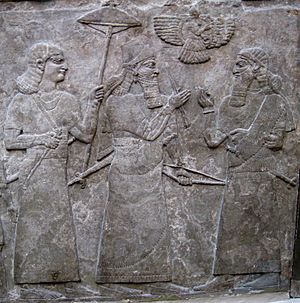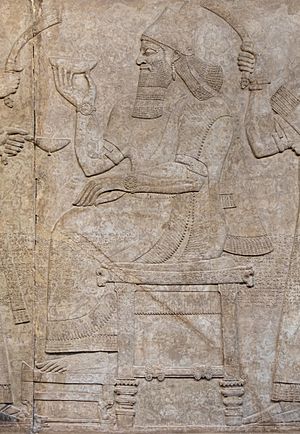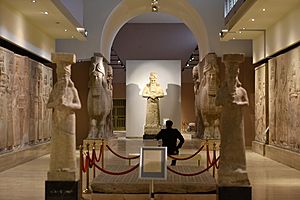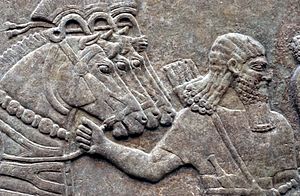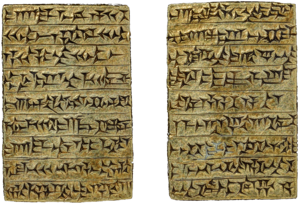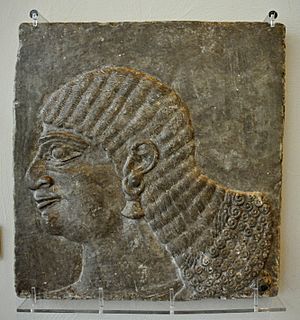Ashurnasirpal II facts for kids
Quick facts for kids Ashurnasirpal II |
|
|---|---|
|
|
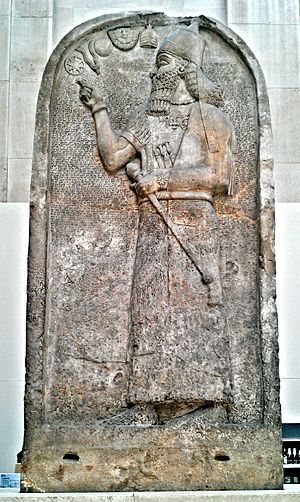
Stele of Ashurnasirpal II at the British Museum.
|
|
| King of the Neo-Assyrian Empire | |
| Reign | 883–859 BC |
| Predecessor | Tukulti-Ninurta II |
| Successor | Shalmaneser III |
| Died | 859 BC |
| Spouse | Mullissu-mukannishat-Ninua |
| Father | Tukulti-Ninurta II |
Ashur-nasir-pal II (which means "Ashur is guardian of the heir") was a powerful king of Assyria. He ruled from 883 to 859 BC. During his time, Assyria became a very strong empire. He was known for expanding his kingdom and building a magnificent new capital city called Kalhu, also known as Nimrud.
Ashurnasirpal II became king after his father, Tukulti-Ninurta II, passed away in 883 BC. He started a huge plan to make his empire bigger. First, he conquered lands to the north in Asia Minor, reaching as far as Nairi. He also collected taxes from Phrygia. Then, he moved into Aram (which is modern Syria). There, he conquered the Aramaeans and Neo-Hittites living between the Khabur and Euphrates Rivers.
His strict rule led to a rebellion, but he crushed it completely in a two-day battle. After this victory, he marched all the way to the Mediterranean Sea without anyone stopping him. He collected taxes from Phoenicia. When he returned home, he moved his capital city to Kalhu (Nimrud).
Contents
Ashurnasirpal II's Family
Ashurnasirpal II's father was Tukulti-Ninurta II. His son, who became king after him, was Shalmaneser III. His queen was named Mullissu-mukannišat-Ninua.
His Time as King
The amazing palaces, temples, and other buildings Ashurnasirpal II built show how rich and artistic his kingdom became. He was known for being very tough. He used people he had captured to build a new Assyrian capital city at Kalhu (Nimrud) in Mesopotamia. There, he built many impressive structures.
He was also a smart leader. He realized he could control his empire better by putting Assyrian governors in charge. This was more effective than relying on local rulers who might not always be loyal.
Military Campaigns
Like earlier Assyrian kings, Ashurnasirpal fought battles along the Euphrates River against the Aramaeans. He also campaigned in the Diyala region against Babylon. Ashurnasirpal II's harsh treatment of rebels made sure that even when his army wasn't around, there wouldn't be more revolts. If there were more rebellions, the local ruler would be replaced with a governor who was loyal only to the Assyrian king.
He led his army, which usually included infantry (foot soldiers), heavy and light cavalry (soldiers on horseback), and chariots. With this army, he conquered the Hittites and Aramaean states in northern Syria.
Ashurnasirpal II did not destroy the Phoenician/Canaanite cities he conquered. He couldn't capture Tyre, a city led by Ittobaal. Tyre then set up a trading post in Kition in Cyprus and opened trade routes across the Aegean Sea, including at Rhodes and Miletus. These cities, through the taxes they paid, became important sources of materials for his armies and building projects. Iron was needed for weapons, Lebanese cedar wood for construction, and gold and silver to pay his troops.
Balawat Gates
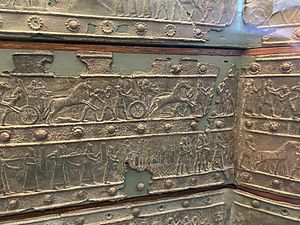
The Balawat Gates, also known as the Balawat Bronze Bands, are three sets of decorated bronze strips. These strips once decorated the main doors of several buildings at Balawat (an ancient city called Imgur-Enlil). Two of these sets are from the time of Ashurnasirpal II. The third set shows the achievements of his son, Shalmaneser III.
After the Neo-Assyrian Empire fell and Balawat was destroyed, the wooden parts of the gates rotted away. However, most of the bronze bands still exist and can be found in different museums today. The original gates were very tall, about 6.8 meters (22 feet) high.
The gates were first found by an Iraqi archaeologist named Hormuzd Rassam in 1878 during a British Museum trip. They were discovered in the doorway of the king's palace. That set of Balawat Bronze Bands is now on display in London. Another set was found by Sir Max Mallowan in 1956 in the Temple of Mamu, a Mesopotamian goddess. This set was displayed in the Mosul Museum in Iraq, but much of it is now missing due to looting in 2003 and further destruction in 2015.
These sets include 32 bands with pictures made from embossed bronze. They also have cuneiform writing. They give us a lot of information about Assyria and the surrounding region in the 800s BC.
Palace of Kalhu

Ashurnasirpal II's palace in Kalhu (Nimrud, which is in modern-day Iraq, north of Baghdad) probably started being built around 878 BC. It is believed to have been finished after about 15 years, around 864 BC, along with the rebuilding of most of the Middle Assyrian city. An inscription describing its opening celebration mentions a ten-day feast attended by 69,574 people!
The palace walls were covered with carvings made from alabaster stone. These carvings had detailed pictures, many showing the king surrounded by winged protective spirits. Others showed him hunting or leading military campaigns. Each carving also had writing on it. This writing was the same or very similar on every carving and is called the Standard Inscription. This inscription tells about Ashur-nasir-pal II's family history, his military victories, the borders of his empire, how he founded Kalhu, and how he built the palace. Ashurnasirpal II also built a huge gateway at Nimrud.
The British archaeologist Austen Henry Layard dug up Kalhu in the 1840s. He uncovered the North-West Palace of Ashurnasirpal II. Today, many of the carvings and sculptures from Nimrud are shown in museums. The British Museum in London has many, including the Statue of Ashurnasirpal II and the Black Obelisk by his son Shalmaneser III. Other carvings are in museums in Europe (like Munich), Japan, and the USA.
Nimrud Palace Carvings

After Assyria fell in 612 BC, the palace became overgrown and eventually buried. It stayed that way for almost 2,500 years until it was found again by A.H. Layard in 1845. Layard oversaw the digging of the palace. During this time, the carvings that covered the walls were removed and sent to collections across Europe and North America. The British Museum received most of these Nimrud carvings.
Even though many carvings were removed, a large number stayed in the palace and were eventually buried again over time. M.E.L. Mallowan dug up the site again from 1947 to 1957. After that, the Iraq Department of Antiques took over the project and still manages the site. The known area of the palace is 200 meters (656 feet) from north to south and 120 meters (394 feet) from east to west. This is likely only part of the original design. All the palace walls were covered with stone slabs, most of which were decorated with carved images.
What the Carvings Show
Around 870 BC, the carved images became very similar. Carved into every stone slab, even the plain ones, was the Standard Inscription. This text listed the king's names and titles, talked about his connection with the gods, and summarized his military victories. The text also described the founding of Kalhu and the palace itself.
The slabs with carvings showed Ashurnasirpal's royal ideas. These ideas focused on four main things: the king's military success, his service to the gods (which brought divine protection), and Assyrian prosperity. The carvings show a special interest in the bodies of both humans and animals. Royal hunting scenes are some of the most famous Nimrud carvings, especially those showing Ashurnasirpal II hunting lions. There is also a clear interest in the relationship between humans and animals in many scenes. In several pictures, the king is shown with supernatural creatures that are a mix of animal and human. All the protective figures, which decorated the palace doorways, were these human and animal hybrids. There were three main types of these figures: a winged figure wearing a horned crown (symbolizing a god), a winged figure with a headband of rosettes, and a winged human figure with a bird's head.
Common Themes in the Carvings
Other popular themes in the Nimrud carvings included military campaigns and Assyrian victories. More specifically, these showed the relationships between Assyrians and non-Assyrians. The Assyrians were always shown in moments of glory. Non-Assyrians were shown in twisted or fallen positions. These pictures showed violent death as punishment for going against Assyrian values. They also showed harsh punishment for wrongdoings. This would have been a clear message for visitors from other cultures. It was also a warning to Assyrian nobles about what could happen if they dared to challenge the king. Ordinary people probably didn't see these carvings often, as they were rarely allowed into the palace. Nobles usually only visited the palace for special ceremonies and business with the king. Assyrian women are usually not seen in these carvings. This is likely because the carvings focused on activities dominated by men.
The Site After Excavations
Not all the carved sculptures have been removed from the palace at Nimrud. Many can still be seen where they originally were, though access is limited. Many museums that display the Nimrud carvings try to recreate the palace feeling by showing them in a similar way to how they were originally placed.
In November 2014, it was reported that ISIL (a terrorist group) had looted many of Iraq's ancient sites, including Ashurnasirpal II's palace. They were selling the artifacts illegally. According to Aymen Jawad from Iraq Heritage, "Tablets, manuscripts and cuneiforms are the most common artifacts being traded, and, unfortunately, this is being seen in Europe and America. Hundreds of millions of dollars’ worth of irreplaceable pieces are being sold to fund terrorists."
On March 5, 2015, ISIL reportedly began destroying Nimrud. The local palace was bulldozed, and the lamassu statues at the palace gates were smashed.
Where to See Nimrud Carvings Today

United States
- Minneapolis Institute of Art, Minnesota - Winged Genius
- Princeton University Art Museum, New Jersey - Winged Genius
- Yale University Art Gallery, Connecticut - items of the collection
- University of Chicago Oriental Institute, Chicago - relief
- Mead Art Museum, Amherst, Massachusetts
- Williams College Museum of Art, Williamstown, Massachusetts
- Museum of Fine Arts, Boston, Massachusetts
- Brooklyn Museum, New York
- Metropolitan Museum of Art, New York - items of the collection
- Hood Museum of Art, Hanover, New Hampshire
- Walters Art Museum, Baltimore, Maryland
- Museum of Fine Arts, Houston, Texas
- Kimbell Art Museum, Fort Worth, Texas
- Saint Louis Art Museum, Missouri
- Nelson Atkins Museum of Art, Kansas City, Missouri
- Fleming Museum of Art, Burlington, Vermont
- Bowdoin College Museum of Art, Brunswick, Maine
- Fine Arts Museums of San Francisco, Palace of the Legion of Honor
- Los Angeles County Museum of Art
United Kingdom
- British Museum, London
- Fitzwilliam Museum, Cambridge
- National Museum of Scotland, Edinburgh
- The Burrell Collection, Glasgow
Europe
- Pergamon Museum, Berlin, Germany
- Staatliche Sammlung für Ägyptische Kunst, Munich, Germany
- Skulpturensammlung, Dresden, Germany
- Calouste Gulbenkian Museum, Lisbon, Portugal
- Royal Museums of Art and History, Brussels, Belgium
Middle East
- Basra Museum, Iraq
- Iraq Museum, Baghdad, Iraq
- Mosul Museum, Iraq
- Sulaymaniyah Museum, Iraq
- Erbil Civilization Museum, Iraq
- Basra Museum, Iraq
- Museum of the Ancient Orient, Istanbul Archaeology Museums, Turkey
See Also
 In Spanish: Asurnasirpal II para niños
In Spanish: Asurnasirpal II para niños
- Kurkh Monoliths
- Lamassu


